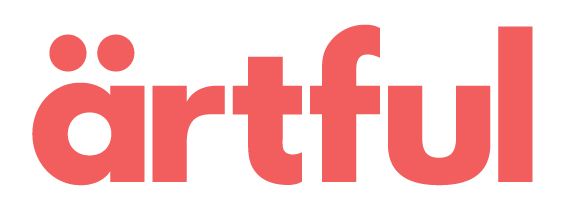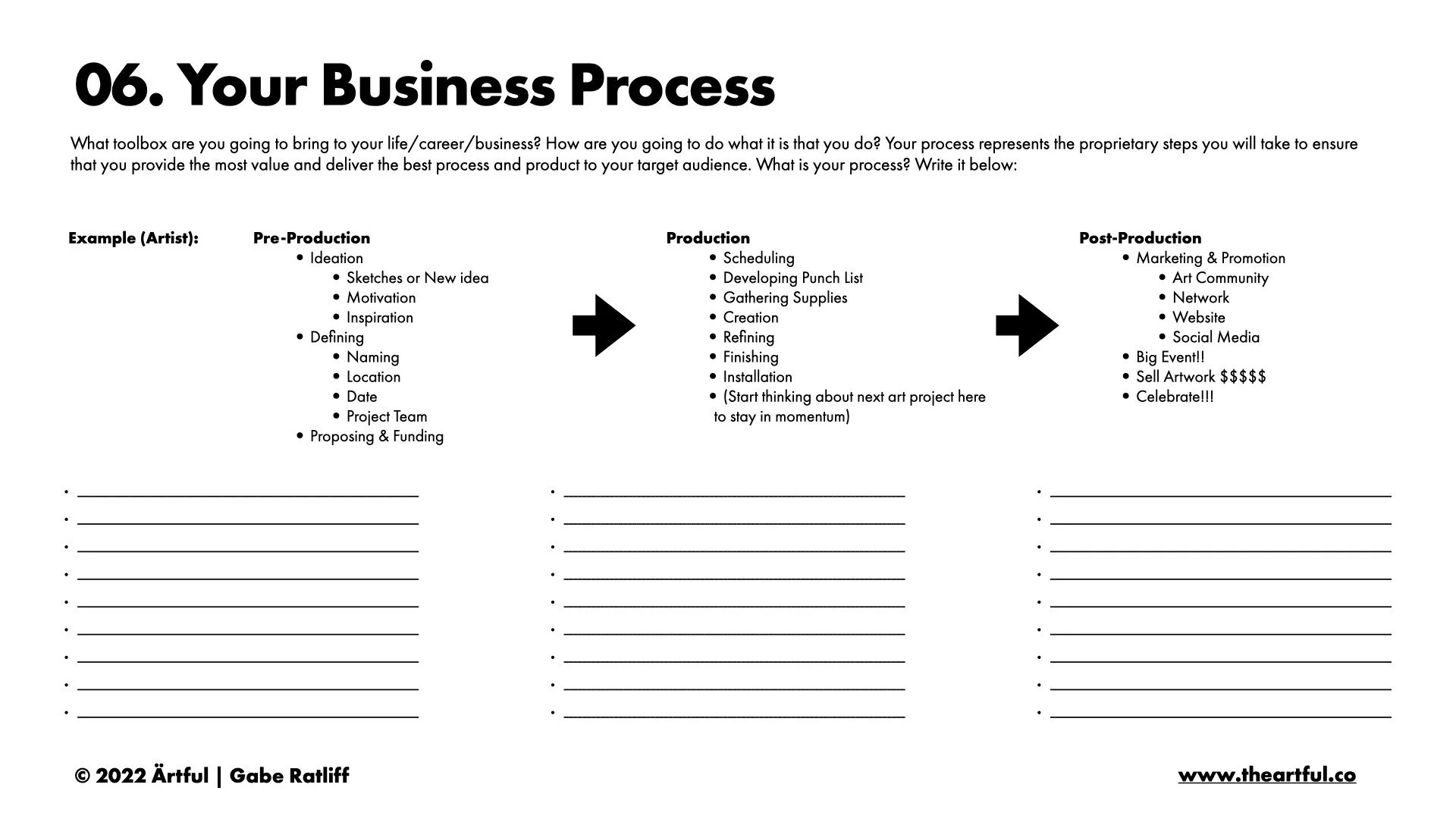Do You Know Your Process?
Do you feel like if you did map out your process you’d be boxed in or a conformist? As creative beings, many of us don't like to paint in the lines or feel constrained. We like to be free to create.
Below is a screenshot from the Create Your Artful Life guide that shows step six where you define your process. The example here is from a coaching session with one of my clients who is a working artist. He didn’t think he had a process and didn’t even know where to start creating one. Within one session we created a customized process specific to his workflow from ideation to completion of a project. He also wasn't celebrating at the end of projects so he was missing out on that closure before starting a new one. He shared he was getting post-project depression because all of that work was done and he had to start all over again. That build-up without closure and a method for preparing for the next project made the slump in between projects even harder and longer. A bit of a break after a project’s completion is great. Knowing your pre, production, and post-process, a workflow I learned in the film/media production industry, is critical to moving forward on projects and keeping your momentum because you know what’s next as you near the end of them.
Now my client can prepare for the end of the project and can begin thinking about the very early ideas for his next project so the break in between isn’t longer due to uncertainty about his process and the depression at the end of projects. We were also able to uncover how many projects he will plan to do each year, how long they will take, and how many hours projects take on average. Knowing this macro view of his business process along with his creative process allows him to plan out his schedule for the year. He can plan on blocking enough time for each project so he’s not stressed and under a time constraint because he didn’t block enough time. He can pre-determine labor projections as he works on his project supply list, and can quickly and confidently set the pricing on his projects and artwork. The internal and external benefits of mapping out your creative and business processes are game-changers!
Routines or habits (ie. Micro-habits, stacking habits) can act as cues to your brain. In his book Atomic Habits, James Clear talks about using ‘triggers’ and ‘cues’ to simplify transitions from one habit to the next. You can apply these to all kinds of tasks so you can accomplish more throughout your day or week (and beyond). The funny thing is we do these inherently and don’t realize it. When you wake up in the morning and are still foggy-headed, dreamy, and somewhat on autopilot, you might make your bed and then go to the bathroom for a bio break and brush your teeth. You might grab your phone first thing and start to scroll your feeds or read emails on your way to the coffee maker of your choice. Maybe you have to let the dog out and get in a quick, chilly morning stroll before waking up the kids so they can get ready for school. We all create our own habits throughout the day. We just might not be thinking about them intentionally. Bookend your day with small wins that not only set you up for a successful day but success in your life and business. What habits work best for you and your day?
Schedules work very similarly. Some people like to block their days for specific tasks, like admin, accounting, invoicing, and content creation. Others like to block specific sections of their day to do things like meetings, writing, creative work, and checking and responding to emails. There are several ways to block time that can support you and your productivity. Some people like to use the Pomodoro technique where you focus on a task for 30-45 minutes then take a short 5-minute break with a longer 15-minute break every few rounds. Some people will extend that and work 1-2 hours straight with a longer break in between. Another way to block your day is to set your morning for internal work, like developing, creating, writing, and researching. Then in the afternoon after breakfast or lunch, have meetings with clients, record podcasts, and do client work. Personally, I love having my morning for internal work. I haven’t started to take in input from external sources yet, and the early hours after lucid dreaming tend to be my most creative, muse-inspired times of the day. I prefer my afternoons for external work and conversations. What time-blocking techniques have worked best for you?
Processes are where we get to bring it all together. As solopreneurs or freelancers, they can seem less important. Once you start to think like a business owner and step into that role, processes become much more important. As you shift toward growing your business automating, delegating, and eliminating become key to your success and optimizing your time. If you are constantly feeling overwhelmed and behind on work, like emails, projects, follow-ups, and calls with new or existing clients, it’s time to look at your habits, schedule, and processes. Knowing your process in your creative work is helpful. Knowing your process across your creative business is pivotal to its survival. It’s a competitive world out there and can feel even more so with social media and the subjective cancel culture mob that has been enabled by it. By getting clear on your creative process and your business process, you can begin to see inefficiencies as well as opportunities. Take a beat. Slow down. Reassess how you spend your time throughout your day and week. Are there tasks you can group together and get done and out? Do you have things built into your process like a celebration when you complete a project? That goes for your own work or client work. Make an event of it. It will add an opportunity to surprise and delight clients.
I invite you to download your copy of the Create Your Artful Life guide and start working on your process. Use this example to start mapping out your process. It doesn’t matter if you’re a graphic designer, video editor, artist, or author. We all have a process. You may just not want to define it. As I mentioned earlier, some people (myself included) don’t want to feel boxed in or conforming when it comes to routines, scheduling, and processes. I know. I was one of them. What I learned is that routines (or habits), schedules, and processes can actually set you free.

